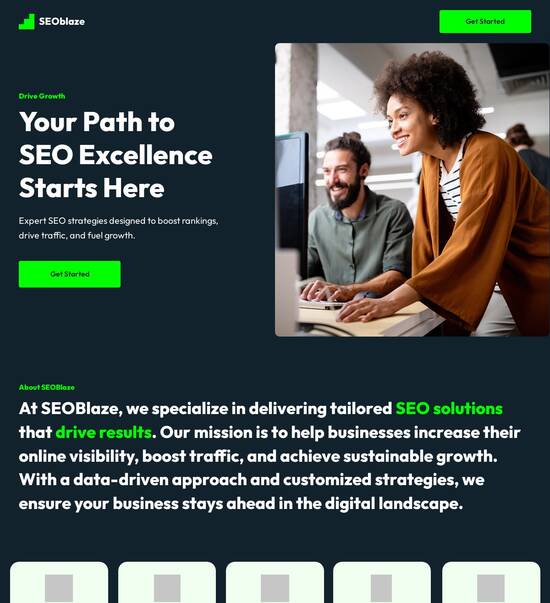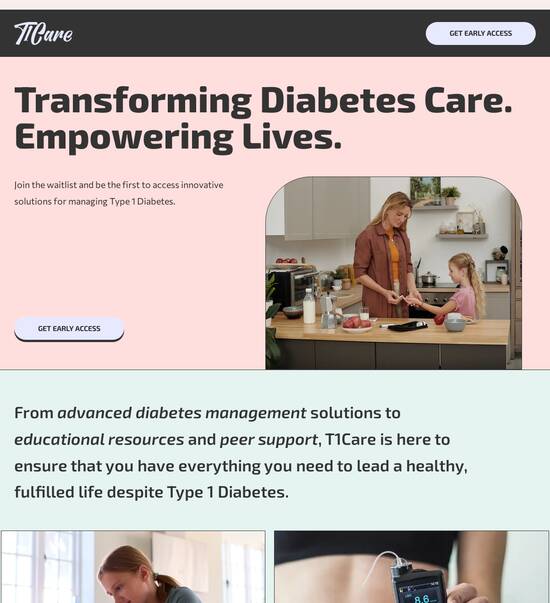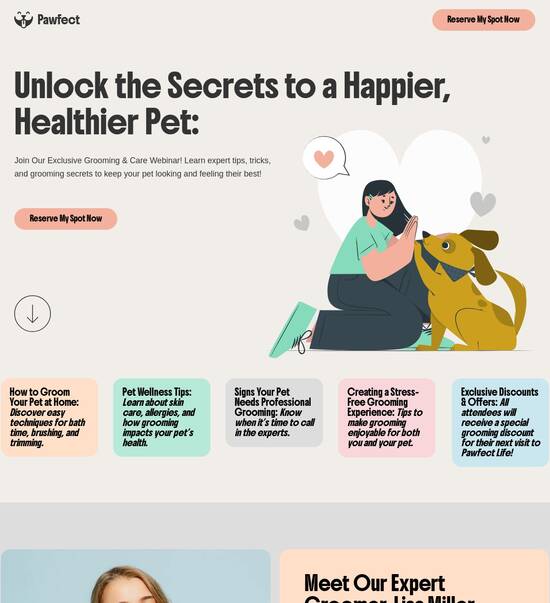
Landing page template for logistics providers
Use TemplateAbout template
Engage your audience like never before with stunning landing page templates for logistics providers. Make your online presence unforgettable!
Recommended templates

Easy to build without coding
With the intuitive drag-and-drop builder, anyone on your team can create high-converting pages without any knowledge of code or design. Make enhancements to your landing page with custom widgets using Javascript, HTML/CSS, or third-party scripts.

Multiple layouts for any industry and goal
Select from 500+ landing page layouts built to boost conversions across industry-specific scenarios. Customize them by adjusting fonts, adding images, and generating on-brand content with the AI assistant. Quickly scale with Instablocks® and Global Blocks that you can save, reuse, and update globally.

Loads fast and looks polished on any device
Every template is responsive, which means they present professionally on any device and load blazingly fast with our Thor Render Engine. You can also power them up with Google AMP technology to deliver an unparalleled mobile experience and drive higher conversions.

Robust analytics & experimentation
Get real-time updates and reporting across all your devices, showing the number of visitors, conversions, cost-per-visitor, and cost-per-lead. Launch AI-powered experiments, run A/B tests, and use heatmaps to analyze user behavior, then optimize your landing page to maximize conversions.







Easy to build without coding
With the intuitive drag-and-drop builder, anyone on your team can create high-converting pages without any knowledge of code or design. Make enhancements to your landing page with custom widgets using Javascript, HTML/CSS, or third-party scripts.
Multiple layouts for any industry and goal
Select from 500+ landing page layouts built to boost conversions across industry-specific scenarios. Customize them by adjusting fonts, adding images, and generating on-brand content with the AI assistant. Quickly scale with Instablocks® and Global Blocks that you can save, reuse, and update globally.
Loads fast and looks polished on any device
Every template is responsive, which means they present professionally on any device and load blazingly fast with our Thor Render Engine.
Robust analytics & experimentation
Get real-time updates and reporting across all your devices, showing the number of visitors, conversions, cost-per-visitor, and cost-per-lead. Launch AI-powered experiments, run A/B tests, and use heatmaps to analyze user behavior, then optimize your landing page to maximize conversions.
All the features you need to build logistics providers template
Explore more featuresLearn how to build top-performing landing pages for any goal
FAQs
Leading the way in building high-performing landing pages





Create effective landing pages with Instapage templates for logistics providers
When it comes to enhancing digital marketing efforts, a tailored landing page template for logistics providers can significantly improve conversion rates. Instapage equips marketers with ready-to-use templates designed to attract leads and optimize campaigns. By utilizing these tools, you can elevate your logistics marketing strategy and maximize ROI.
Understanding landing page templates for logistics
A landing page template is a pre-designed webpage optimized for specific marketing goals. For logistics providers, these templates will typically highlight key service offerings, facilitate inquiry submissions, and drive lead generation. Here’s why investing in a specialized landing page is crucial:
- Simplified lead capture: By using intuitive designs, these templates encourage visitors to submit their information, enhancing your lead generation efforts.
- Customization options: Tailor the content and images to resonate with your target audience, ensuring your messaging reflects the values of your logistics services.
- Analytics integration: Leverage built-in analytics features to track page performance and understand user behavior.
Step 1: Choose the right template
Start by selecting a template that aligns with your specific logistics services. Consider the following key aspects when making your choice:
- Service focus: Ensure the template prominently showcases services such as freight forwarding, transportation, and tracking.
- Call-to-action visibility: Select a design that places strong emphasis on CTAs like 'Get a Quote' or 'Contact Us' directly on the landing page.
- Mobile optimization: With many users accessing sites on mobile devices, ensure the template is responsive to various screen sizes.
Step 2: Customize for engagement
Editing your chosen template to better fit your brand is vital. Consider these elements:
- Branding: Use consistent logos, color schemes, and messaging that reflect your brand's identity.
- Visual elements: Incorporate compelling images or videos of your logistics processes to engage visitors and build trust.
- Clear navigation: Ensure ease of navigation around the page so that visitors can easily find essential information.
Step 3: Optimize for performance
Utilize the built-in optimization tools provided by Instapage to ensure your landing page achieves its desired results. This can include:
- A/B testing: Test different versions of your landing page to find out which variations convert more effectively.
- SEO best practices: Use relevant keywords that your audience is likely to search for, ensuring better visibility in search engine results.
- Conversion tracking: Implement tracking tools to monitor the number of leads generated and their subsequent conversions into clients.
Creating a landing page template for logistics providers with Instapage can be a game-changer for your marketing strategy. Tailor your approach to specific services and continuously optimize for higher performance.
Ready to transform your logistics marketing? Leverage Instapage's powerful platform today and create landing pages that convert.
People also ask about Landing page template for logistics providers
Unveiling the Future: The Ultimate Landing Page Template for Logistics Providers
The evolving landscape of logistics marketing
In a rapidly changing marketplace, logistics providers must prioritize a robust online presence. With customers increasingly turning to the internet for service information, a well-crafted landing page serves as a vital first impression. It's not just about being present; it's about being visible, trustworthy, and engaging. An effective landing page intricately weaves your brand's story and offerings into a compelling narrative that resonates with your audience.
Landing pages are pivotal in customer acquisition because they act as dedicated platforms for targeted campaigns. Unlike general websites that house all company information, landing pages are tailored to guide visitors toward a particular action, whether it's filling out a form, requesting a quote, or engaging with content. This specific focus can dramatically improve conversion rates, allowing logistics providers to capture interested prospects while conveying essential information succinctly.
Decoding the ideal landing page: Key features and components
To create a successful logistics landing page, there are several key features and components that should be integrated. By understanding the basic building blocks, logistics providers can build pages that not only attract attention but also convert visitors into leads and customers. The inclusion of tracking tags is crucial for gathering insights about user interactions. These digital breadcrumbs facilitate data-driven decisions and support targeted marketing efforts.
Tracking tags: These should be properly placed to follow user behavior, making it easier to analyze and optimize the landing page.
Contact forms: Clearly structured forms for quotes and inquiries enhance user engagement and facilitate quick communication.
Call-to-action buttons: Visually distinct buttons that encourage user actions should be easily accessible.
The functionality aspect of a logistics landing page cannot be overlooked. Features should support user needs, such as easy navigation, responsive design, and integrated forms for seamless service requests. Whether it's an inquiry form or a quote request, these integrated tools can streamline the process and enhance user satisfaction.
The browser experience: Efficient and seamless
A mobile-responsive design stands out as a critical component for logistics providers. With the majority of users accessing websites via mobile devices, ensuring that landing pages look and function effectively across various devices is essential. A mobile-friendly layout not only enhances user experience but also improves SEO rankings as search engines favor responsive designs.
Loading time plays a significant role in user engagement. Research suggests that users are less likely to stay on a page that takes more than three seconds to load. To ensure faster loading times, logistics providers can utilize techniques like optimizing images, minimizing HTTP requests, and leveraging browser caching. By improving these factors, it's possible to enhance the overall user experience significantly.
Leveraging innovative features: iolazy and beyond
Incorporating cutting-edge technologies like lazy loading can significantly boost the performance of logistics landing pages. Lazy loading ensures that images and other media files are only loaded when they are in the user’s viewport, reducing loading times and improving the first-page experience. This technique has been shown to enhance user engagement and lead to lower bounce rates.
Improved load times: Lazy loading can significantly lower the initial load time of a page.
Increased engagement: Faster pages keep users interested and reduce bounce rates.
Positive impact on SEO: Search engines favor pages that load quickly, aiding visibility.
Integrating engaging video content can also elevate the user experience. Videos that showcase logistics services, fleet capabilities, or satisfied customer testimonials add a dynamic element to the landing page. When embedding videos, it’s essential to use optimal settings to ensure that playback does not negatively impact loading speeds.
Crafting a visual narrative: Colors and fonts
The color palette of a landing page can greatly influence user perception. In the logistics sector, certain colors evoke feelings of trust, reliability, and professionalism. For instance, shades of blue and green can represent stability and growth, respectively. It's beneficial to test different colors to see which resonates most with your audience.
Blue: Invokes trust and dependability.
Green: Symbolizes growth and sustainability.
Gray: Conveys professionalism and neutrality.
Font choices also play a critical role in how information is perceived. Readability is crucial; therefore, incorporating sans-serif fonts often proves beneficial, as they are easier to read online. Moreover, utilizing a combination of font styles can help in establishing a clear hierarchy and emphasizing different sections of your landing page.
Design elements that drive conversion
The header of a landing page is your prime real estate; it sets the tone for what is to follow. Crafting compelling headlines and sub-headlines can draw users in effectively. Think of it as your elevator pitch, encapsulated in a few impactful words. By highlighting what you do best, you can pique visitors' interest right from the start.
Highlight key services or differentiators in bold headings.
Use sub-headlines for additional context and explanation.
Ensure headers are visually distinct from the body text for clarity.
Using a strategic layout with columns can further enhance user engagement. For logistics providers, comparing services or pricing options in a side-by-side format can aid decision-making. Clarity in design fosters trust and encourages users to explore what you have to offer.
Content that converts: Strategies and best practices
The content on your logistics landing page should be structured for flow and easy engagement. Start with an attention-grabbing headline followed by concise value propositions. This presents a straightforward narrative that guides users through your services, making it easier for them to find what they need.
Begin with a strong value proposition that highlights what sets you apart.
Expand on services with clear, concise descriptions and benefits.
Conclude with strong call-to-action prompts that encourage interaction.
Calls-to-action should be compelling and resonate with your audience's needs. Experimenting with different CTA texts and placements can help identify the most effective options that lead to higher conversion rates.
Artful integration of images
Images are powerful storytelling tools for logistics firms. They provide visual context to your services and operational capabilities, establishing credibility. Using imagery that aligns with your brand message can significantly enhance the overall user experience.
Select high-quality images that represent your services accurately.
Utilize images that evoke trust and professionalism.
Ensure images are optimized for web to avoid slow loading times.
Consider alternating between images of your fleet, workforce in action, and satisfied customers to create a well-rounded narrative. Visuals coupled with strong messaging can foster a deeper connection with potential clients.
The footer: An overlooked asset
The footer often gets neglected in landing page design, yet it can serve as a powerful resource hub for visitors. This section should encompass essential elements such as contact information, quick links, and trust signals like certifications or security badges. A comprehensive footer promotes user trust and encourages visitors to explore your site fully.
Include contact information for easy access.
Add quick links to key services or information pages.
Showcase testimonials or client logos to provide social proof.
Incorporating social proof, such as client testimonials or case studies, can significantly enhance credibility. A thoughtfully designed footer can turn a mere navigation tool into an engagement driver.
Addressing common challenges in landing page optimization
Logistics providers often face challenges with design and UX on their landing pages. Common issues include cluttered layouts, inadequate information flow, and slow load times. Identifying these problems is the first step toward a more user-friendly design.
Conduct regular A/B testing to see which elements perform best.
Utilize analytics tools to gather data on user behavior.
Solicit user feedback to identify pain points in navigation.
Using A/B testing allows you to experiment with different layouts, messages, and other elements to discover what resonates best with your audience. Additionally, leveraging user feedback through surveys or usability tests can illuminate issues that might not be immediately apparent.
Empowering users: The download panel
Providing downloadable resources can significantly enhance user engagement on logistics landing pages. Offering brochures, service catalogs, or whitepapers not only showcases your expertise but also helps in capturing leads. By gating content, you invite users to share their information in exchange for valuable resources.
Ensure that the downloadable content is relevant and valuable to your audience.
Create an easy-to-use download interface that guides users through the process.
Utilize clear descriptions for downloadable resources to highlight benefits.
An effective download panel not only adds value to your landing page but also maturely qualifies leads by encouraging prospects to engage further with your business.
Future trends in logistics landing page development
The field of logistics is evolving, and so are the strategies for landing page development. Future trends indicate a move toward more personalized experiences, utilizing AI technologies to deliver tailored content based on user behavior and preferences. This shift will allow logistics providers to cater to individual client needs more effectively.
Increased use of AI and machine learning to understand user preferences.
Integration of chatbots for real-time engagement.
Focus on adaptive content that shifts in response to user interaction.
Successfully adapting to these trends requires logistics providers to stay informed and agile. With technological advancements at their fingertips, the ability to innovate will differentiate top companies from the rest, propelling them into the future.
Ready to skyrocket conversions?
Supercharge your ad campaigns with high-performing landing pages
Get started














